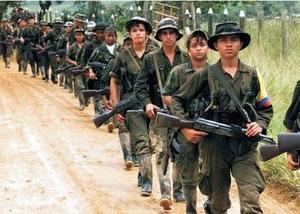In an effort to bring its armed conflict with the Colombian government to a negotiated settlement, the Revolutionary Armed Forces of Colombia (FARC), has made two important concessions. One is the unilateral release of all captured military prisoners, all of them members of the state’s armed forces. The second is the abolishing of their Law 002, which required citizens with incomes greater than $1 million dollars to pay a war tax to the FARC, or be subject to kidnapping. The FARC introduced Law 002 in 2000, after United States and Colombia launched Plan Colombia and the Colombian government introduced its own war tax. Although ransom kidnappings have been a main source of the movement’s finances, generating 40% to 50% of its annual income, they also have angered human rights groups and contributed to FARC’s political isolation.
With these concessions the FARC is taking the political initiative, increasing the pressures on Juan Manuel Santos’s government to initiate peace talks. It remains unclear, however, if Santos will engage the FARC and seek a peaceful end to hostilities before the 2014 presidential election. Santos, who is wrapping up his second year in office, is expected to run for re-election. As a result, Santos will have little time to reach a negotiated settlement with the FARC before the lead-up to the May 2014 presidential election, when he will be in “campaign mode” for his second term.
But if historical experience is relevant at all, no peace can be achieved in Colombia without the blessing of the U.S. government. As I mentioned in previous blogs, the United States—the chief sponsor of the multimillion-dollar military initiative Plan Colombia—is also entering into its own Election Day coma as it heads into its presidential elections, in which Iran has been chosen to be a leading campaign issue alongside the economy. Therefore, I doubt the U.S. government will be in the mood to engage the FARC in peace talks.
In any case, if Santos pursues a path toward peace with the FARC, he will also have to enlist the support of Colombia's agro-business and military elite. These groups, however, fear that if the government negotiates peace with the FARC, rather than defeating it militarily, the costs to them might be higher than what they are willing to pay. To these dominant classes in Colombia, the paradox has always been that the costs of peace are higher than the costs of war.
This calculus of the costs of peace vis-à-vis the cost of war has been the guiding compass of the agrarian and military elite. Keep in mind that this calculus has sustained the continued militarization of Colombia for nearly half a century. Two challenges that confront Santos. First, he has to convince core sectors of Colombian society that continuing this war against the FARC is unsustainable. Second, he must persuade the FARC that land reform, as contemplated in its 10-point Agrarian Program of 1964, ought to be adjusted.
With 2014 on the horizon, Santos may need more time to bring all these pieces together. If a peace deal is reached at all, it is unlikely to come before the presidential election. Until then, Colombians should prepare for more war and more suffering. I only hope that I am wrong.
For more from Nazih Richani's blog, Colombian Cuadernos, visit nacla.org/blog/cuadernos-colombianos, or see "Show Time in Necocli, Colombia" by Nazih Richani, February 8, 2012.

